Juniper jn0-362 practice test
Service Provider Routing and Switching, Specialist (JNCIS-SP) Exam
Question 1
Which statement correctly describes a characteristic of IPv6 unicast addressing?
- A. Global addresses are in the range of 2002::/16.
- B. Only one loopback address exists, ::1/128.
- C. Link-local addresses are in the range of FF00::/8.
- D. Link-local addresses are in the range of FE00::/12.
Answer:
B
Question 2
Click the Exhibit button.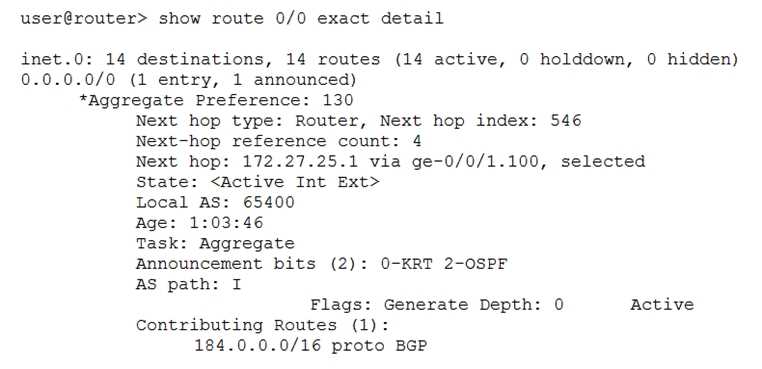
Which type of route is shown in the exhibit?
- A. generate
- B. static
- C. kernel
- D. aggregate
Answer:
A
Reference: https://dataplumber.wordpress.com/2012/02/22/whats-the-difference-between-an-
aggregate-and- a-generate-route-in-
junos/#:~:text=What's%20different%20is%20that%20the,route%20matching%20the%
20packet's%20destination
Question 3
You want to make use of the nonstop active routing (NSR) feature.
Which complementary feature must also be enabled?
- A. IP anycast
- B. graceful restart
- C. Virtual Router Redundancy Protocol
- D. graceful Routing Engine switchover
Answer:
D
Reference: https://www.juniper.net/documentation/en_US/junos/topics/concept/nsr-overview.html
Question 4
Which statement about a virtual-router type of routing instance is correct?
- A. It is used to separate large networks into smaller administrative entities
- B. It is the only routing instance type supported on Junos devices
- C. It is used in Layer 3 VPN implementations
- D. It is used to create and maintain separate routing and forwarding tables
Answer:
D
Question 5
Click the Exhibit button.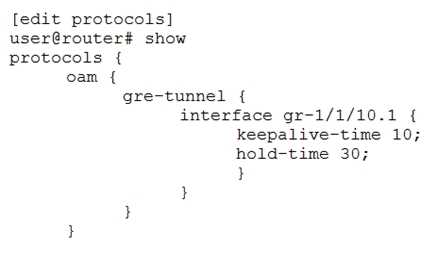
Referring to the exhibit what are two reasons for the configuration stanza? (Choose two.)
- A. to reduce the risk of forwarding traffic through a stateless tunnel
- B. to mark the tunnel down after the hold-time expires
- C. to remove the tunnel interface from inet.0 after the hold-time expires
- D. to mark the tunnel up after the hold-time expires
Answer:
AB
Question 6
Click the Exhibit button.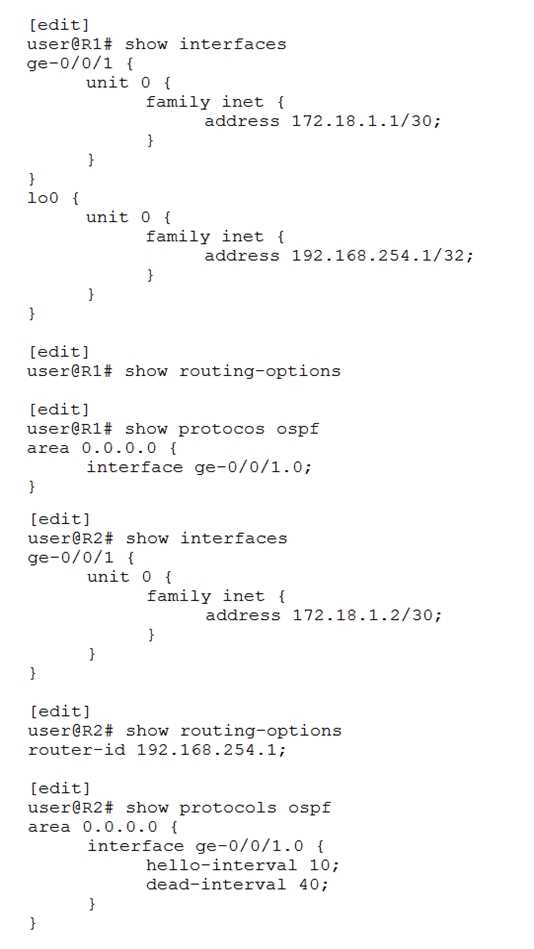
You configured R1 and R2 to form an OSPF adjacency, but the adjacency will not establish. Referring
to the exhibit, which statement correctly identifies the problem?
- A. Hello and dead timers are not matching between R1 and R2
- B. R1 does not have a router ID defined
- C. R1 and R2 have the same router ID
- D. R2 has a wrong area configured
Answer:
C
Reference: https://www.juniper.net/documentation/en_US/junos/topics/reference/configuration-statement/router-id-edit-routing-options.html
Question 7
What is the purpose of STP BPDUs?
- A. to exchange MAC addresses
- B. to determine the least cost path
- C. to determine the root-alternate port
- D. to determine the root bridge
Answer:
B
Question 8
Which IPv6 extension header notifies intermediary devices that they must inspect the packets
options?
- A. destination options header
- B. routing header
- C. hop-by-hop options header
- D. fragment header
Answer:
B
Reference: https://en.wikipedia.org/wiki/IPv6_packet
Question 9
Click the Exhibit button.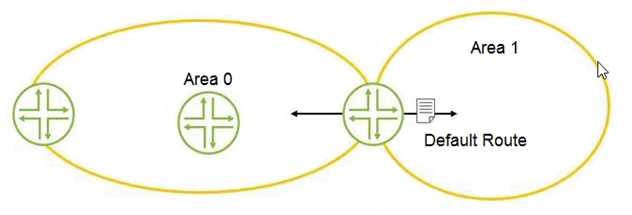
You are asked to configure OSPF for the network? Referring to the exhibit, how should Area 1 be
configured?
- A. stub area
- B. totally stubby area
- C. not-so-stubby area
- D. backbone area
Answer:
A
Reference:
https://www.juniper.net/documentation/en_US/junos/topics/topic-map/configuring-ospf-areas.html
Question 10
Which two characteristics describe IS-IS? (Choose two.)
- A. A collection of Level 1 routers serves as the IS-IS backbone
- B. Level 2 routers connect areas in an IS-IS autonomous system
- C. A collection of Level 2 routers serve as the IS-IS backbone
- D. A Level 1 IS routes between areas and toward other autonomous systems
Answer:
BC
Reference:
https://www.juniper.net/documentation/en_US/junos/topics/concept/isis-levels-understanding.html
Question 11
Which statement is true when using MVRP on MX Series devices?
- A. MVRP works with MSTP and RSTP, but not VSTP
- B. MVRP works with RSTP and VSTP, but not MSTP
- C. MVRP works with MSTP and VSTP, but not RSTP
- D. MVRP does not work with MSTP, RSTP, and VSTP
Answer:
A
Reference:
https://www.juniper.net/documentation/en_US/junos/topics/topic-map/mvrp.html
Question 12
Click the Exhibit button.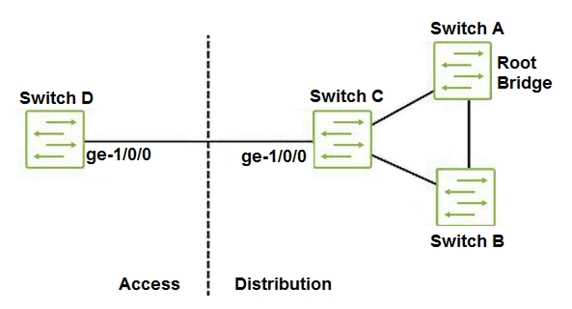
In the network shown in the exhibit, all switches are configured with the default STP root bridge
priority, and Switch A has been selected as root. You recently added the older Switch D into the
network as an access switch, and notice it has taken over as root.
Which configuration would solve this problem?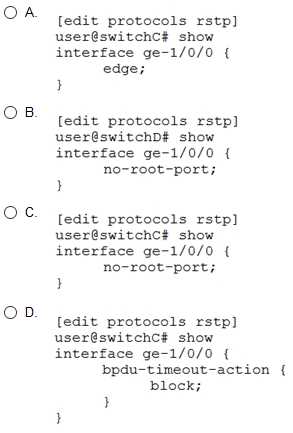
- A. Option A
- B. Option B
- C. Option C
- D. Option D
Answer:
C
Reference: https://www.juniper.net/documentation/en_US/junos/topics/reference/configuration-statement/no-root-port-edit-protocols-stp.html
Question 13
When working with an MPLS LSP, what will the install 172.16.6.0/24 active command accomplish?
- A. The command will swap the prefix from inet.0 to inet.3
- B. The command will swap the prefix from inet.3 to inet.0
- C. The command will install the prefix in inet.0 rather than inet.3
- D. The command will install the prefix in inet.3 rather than inet.0
Answer:
D
Reference:
https://www.juniper.net/documentation/en_US/junos/topics/topic-map/lsp-routes.html#id-21214
Question 14
Click the Exhibit button.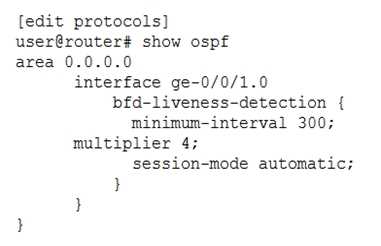
Referring to the exhibit, how many milliseconds must pass before the interface ge-0/0/1.0 is
considered down?
- A. 1200 ms
- B. 900 ms
- C. 1600 ms
- D. 2400 ms
Answer:
A
Question 15
Click the Exhibit button.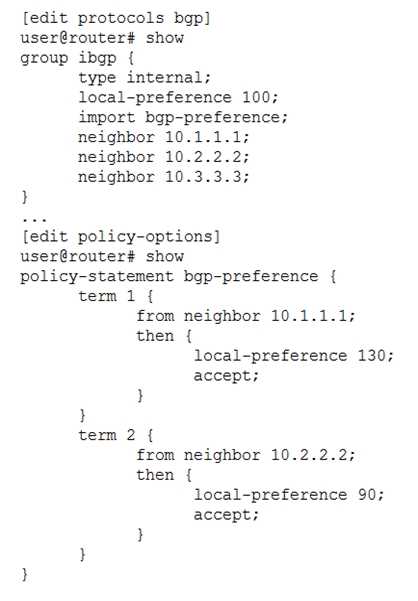
Referring to the exhibit, which statement is correct?
- A. Routes from 10.1.1.1 are less preferred than the default local preference
- B. Routes from 10.2.2.2 are less preferred than routes from 10.1.1.1
- C. Routes from 10.3.3.3 are less preferred than the default local preference
- D. Routes from 10.1.1.1 are less preferred than routes from 10.2.2.2
Answer:
B